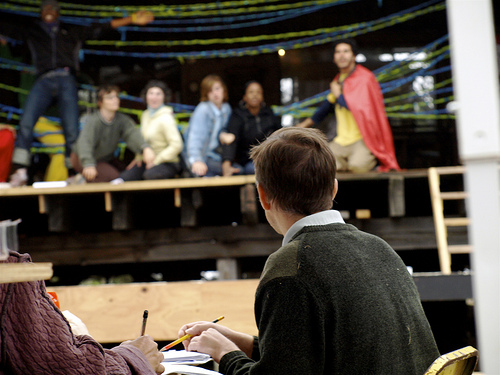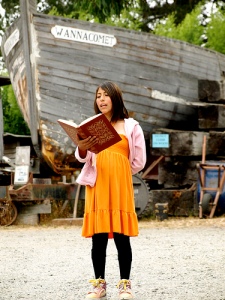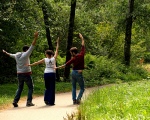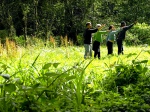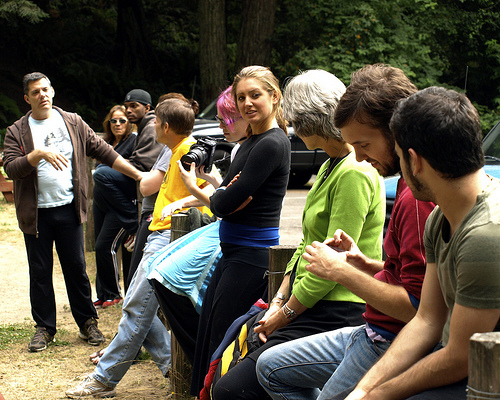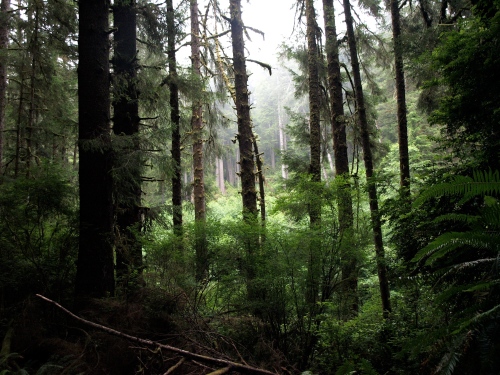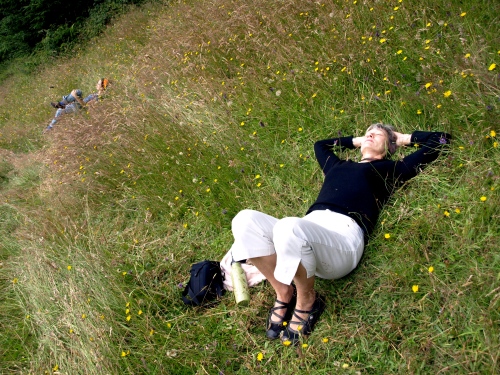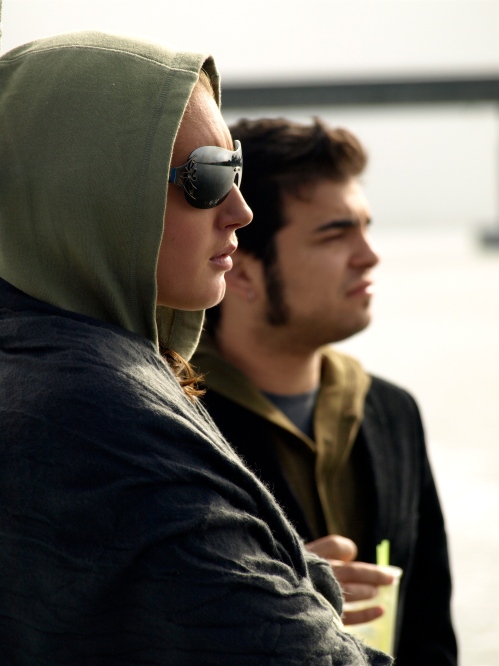
Sage Howard & Adam Sussman look at what is left of Indian Island as we tour around the bay on the Madaket Boat. Massacre and tragedy occurred on this Island, the center of the world for the Wiyot people.
by Sage Howard
Oh Eureka.
I remember the first time I learned the word ‘Eureka’. My family had a
Eureka! tent I first remember taking to the Pioneer Mountains in
Montana. The tent was a series of grays, like the series of grays of
the skies in our new home: Eureka, CA. Here in this big tent of
Eurekan sky, surrounding the land locked-bay, we experience varying
degrees of sun or storm shining through the ceiling. Like the tent we
took backpacking, there are no walls, but a gentle slope, like the sky
comes down to touch the bay- and the gray continues.
When you go backpacking, you expect to remember hiking, but like most
expectations, it’s broken. I can’t articulate specific expectations I
had coming to Eureka, but I can articulate some of the ways my
unconscious expectations have been broken. The roller coaster of
emotions, personal, institutional, communal- is overwhelming,
cleansing, hilarious, and ultimately healing. Healing is rarely
without pain, openness, and intense vulnerability. But with
vulnerability comes connection and strength.
So, speaking in abstractions . . . that’s what I have been doing,
which is the first level of universal introduction so you know that
this is a story you can relate to, but now it is time for some
specifics. The biggest expectation broken since I have been here is
the relationship between the Wiyot tribe and us. I entered into the
institute expecting we would have an intense and incredible connection
with the Wiyot tribe, the people native to this particular area. Well,
I assumed wrong. Peter Howard, our playwright, had gone up to the
reservation, Table Bluff, multiple times over the nine months he and
Paula Donnelly were here conducting interviews, hosting story circles
and gathering the material that became the basis of the script.
Peter’s invitations to participate, which were careful, respectful and
thoughtful were met with a closed and silent reception on the
reservation.
I want to highlight that Peter is one of the most thoughtful,
respectful and intelligent human beings I have ever met, let alone
worked with. This tangent is to emphasize that his choice to include
only one Wiyot woman in the show, Maggie, was a carefully considered
and a wise choice because we did not know if we would have any people
of Wiyot heritage come to auditions. Leah and Leslie followed up
Peter’s invitations by returning to the reservation, posted signs
about auditions, and engaged in gentle conversations with the cool
reception they received as well.
Now, I want to make sure that this does not sound like I am placing
blame on the people who work at the reservation cultural center or
(what we have perceived to be) the Wiyot decision to not open up and
jump on board. Who are we to come crashing into a community and demand
stories? Their history and relationship to this land is one of
struggle and there is an immense amount of pain that lives in the air.
This one play, this one month, is not the place to tell their story.
It’s theirs. A play will not solve the pain and complications of what
they have experienced.
So, what is this history and pain that I allude to? As all Native
tribes, the Wiyot people suffered massacres, relocations and harsh
assimilation. Specifically, there was an intense effort to eradicate
the Wiyot population because the center of their world was the bay and
the land and islands of Eureka, sought after intensely by the
settlers. There was a devastating massacre in February 1860 that
interrupted a sacred dance celebration that marked the renewal of
their world each year. Hundreds of people were killed in one night in
an organized effort by settlers who were coexisting previously with
the Native People. I cannot give you all the information now, but I
urge you to check out these website and read further the history of
the Wiyot people and the projects they are currently undergoing to
rebuild their culture:
The general website where you can find a further history:
http://www.wiyot.com
On rebuilding Indian Island, the center of the Wiyot world where the
New Year celebration took place for thousands of years:
http://www.wiyot.com/tuluwat-project
Clearly, Jason and the Golden Fleece is not the story of Eureka. This
is a story of Eureka. That said, we couldn’t leave that vital voice
out of story either. We hoped that there would be a voice of Maggie
who was Wiyot, and so eagerly we waited at auditions for that magical
woman to walk through the door.
No one came.
There were discussions in the casting meetings of representation and
how to cast this role. These discussions, I imagine paralleled the
discussions that we have had in class, about our responsibility
creating community-based theater. This work will change the places and
people that we work with. How we speak about things and how we
approach the work. Through this conversation, Laurie and Peter decided
to cast me as the Wiyot women, Maggie. This is has been an incredible
challenge. I don’t know that I have ever felt such responsibility as
an actress. The value of having the community immediately there
hightens the responsibility for honesty and truth. Time to do
homework.
So, Ramy and I went up to the Reservation, Table bluff, this past
Monday. We met two amazing people: a linguist, Lynnika Butler and Ben
Brown. Lynnika is the official Language Project Manager on the
reservation, who is trying to rebuild the language, learning the
language and teaching the language. Quite apt to talk to her because
Maggie, the woman I am playing in the show is also a linguist trying
to revive the language. Ben is currently cataloguing the artifacts
from burial grounds that are being returned to the Wiyot community
under the NAGPRA, Native American Grader Protection Repatriation Act.
Ben is also in charge of all the Native American artifacts at the
Clark Museum in Historic Downtown. While they were a little bit
skeptical when we came into the center asking if we could talk tot hem
because we were theater artists from Los Angeles. Speaking honestly
about the project and our desire to be accurate and respectful of the
history, struggle and beauty of their community opened Ben and Lynnica
up. Ben happened to be going to the Clark, although it was Monday and
the museum was closed, he offered to give us a private tour of his
area of expertise. Yes. So, we met him on the steps of this grand old
building down town.
Ben Brown gave us an amazing tour, but the discussion brought up was
priceless. I can’t tell all now, but I will give you an example of the
holistic power of the people who were here and lived in the bay
‘pre-contact.’ What struck me most was the holistic nature of life
practiced, lived, by all the tribes. I recognize that I am going to
sound idealistic, simplistic and overly romantic about their
connection to nature, spirit and their place in the cosmos here.
Really, I am in awe. Humbled. Everything in their life was a balanced
mixture of spiritual and functional. Their baskets, for example, are
intricate simple patters of tightly woven reeds and grasses. Everyone
wore a woven cap and the baskets were used everyday in everything from
storage, collection to boiling water. Yes, they created a basket that
was watertight and could with stain heat. Ramy asked a simple and
powerful question, “Where these functional or do the patterns have
specific meaning?” Ben replied, “Well it was certainly not Church on
Sunday, work on Monday. The functional and spiritual was woven into
everything. It was holistic . . . (he was at a loss of the right
words). The women wove the baskets and the patterns came from their
dreams. When they wove the baskets, they said a prayer with every
knot.” Wow. No wonder the grass held in the water and could also
withstand fire. Such incredible intension in each action. We continued
on and I asked about how they chose their leaders. Ben told us that
they were the wealthiest members of the community. That seemed odd and
I was a little put off as we wandered over to the next display case
where Ben pointed out the thin shells, NAME, used as currency. “This
was their money,” Ben said, “But you have to understand that it was
not exchanged for materials as much as it was a moral currency. If you
did someone wrong you had to pay them. Therefore, the people who were
the wealthiest in the community were the ones who cared the most, the
ones who did not do ill to others. They were the most moral upstanding
citizens of their community. They were the caretakers.” What a
concept, to trust and the power of leadership to those who care.
At that point it was time to go on a tour of the bay with the rest of
our Institute community. Eric (the man who owns the Blue Ox) has a
friend who owns The matticate, a wonderful old boat with the smallest
licensed bar in California. They are proud. From the reservation, to
the museum, I was a whirl of history and emotion and thought, and we
launched out into the water, passing by Indian Island, the center of
the Wiyot world. I consider myself to appreciate and love nature, but
I realized on a new level the lack of connection that we have with
place. With trees, water, air, mist and cycles of sun and moon. In
anticipation of going back to LA and Orange county, where I am certain
the majority of citizens do now know the history or the power of the
place they drive over everyday, I want to continue on my own awakening
and invite people to join on their awakening of what was here, what is
here, and what is possible. I do know that if we can make theater like
the Wiyot wove baskets, with a prayer, and intension of every knot, we
can change the world.
More links:
On the language and it’s rebuilding
http://www.wiyot.com/language




